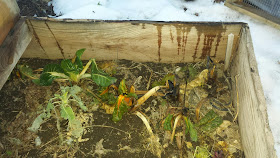Thinking about year-round gardening and winter gardens might conjure up images of kale surrounded by snow, and last year's carrots being dug out from under the mulch in January. These are wonderful components of a year-round garden. Once spring begins to show its face, we turn our attention to planting for the new growing season. But what do you harvest after the winter garden has pretty much been eaten, and the new growing season is in its infancy?
This year I tried fall-planting some seeds that I knew wouldn't mature on time for the dead-of-winter garden. I also left some key plants in the ground during autumn harvest. Of course there are also a few precious perennials that don't mind the cold weather, either. Today I'd like to share how these methods have translated into an active late winter and early spring garden.
Outside of the garden, my composted manure pile is frozen hard as a brick. But here in the aspen hotbed, the soil is supple, and these Egyptian walking onions are hanging in there.
New onion greens are coming up, sprouting from onion bulbs that fell off the top of last year's walking onions. (This is a perennial onion.)
During harvest time last fall, I left a few onions in the ground, which now means green onions in late winter! (This onion variety would normally be viewed as an annual, but I'm growing like a perennial.)
Today I harvested the first radish of 2016, in the tipi greenhouse. Note how sickly the top of the radish looks, and yet underneath the soil was a beautiful salad-ready radish. I planted this seed last fall, and it sprouted and grew just a little before winter hit. Little did I know that it has been steadily growing, perhaps as the days have started to get a little longer and milder.
Last autumn, I accidentally sprouted a bunch of onion seeds (they got wet), so I laid them in the soil in the tipi greenhouse. Now they are coming to life! Soon I will be cutting green onions from their tops. It's an accident worth repeating.
I had no idea that this purple kohlrabi was hanging in there, in a cold frame that my Dad made for me, using a window from a workshop upgrade. This winter garden produce was missed during the core of winter -- and therefore is available for spring, when I've only just put kohlrabi seeds in the soil. I think I'll let it grow a bit bigger.
This is a third generation garlic plant -- each year, I keep leaving it in the soil, and it provides me with lots of garlic greens as one of the year's first salad offerings.
And now for the dark side of our microclimate: it isn't all peaches. Warmer soil means that we ALREADY have lots of slugs, pill bugs, and who knows what other competition for our goods. However, I'm working on making room in my heart for pill bugs, since they mainly like to eat dead and decaying matter, similar to earthworms, which will help the garden. I hear that they can also take in heavy metals, so they can do some serious good. (They also like tender young shoots... I will plant twice as many bean seeds as I actually need, and hopefully there will be enough seedlings left after the pill bugs are through.) Slugs however, seem to take more than they give. I'm working on appreciating the fact that they serve as food for some of the birds that enjoy the garden.
All in all, cultivating a milder, more moist microclimate is worth it to me.





























